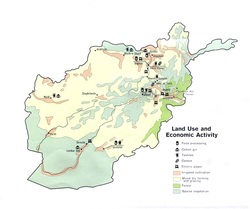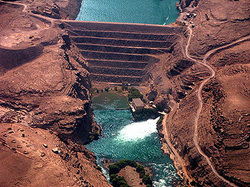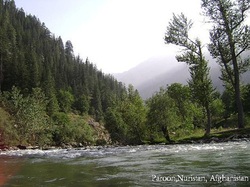NATURAL RESOURCES

Afghanistan has many natural resources. According to a study by the United Nations Environment Programme (UNEP), 80% of the Afghan people are dependent on natural resources. Most of the Afghan people do agricultural work: raising crops or sheep. Water the vital component for living and farming is scarce in much of Afghanistan. Some of the other natural resources that can be found in Afghanistan include metals, natural gas, and precious stones. Because of the lack of industry many of these resources are not easily accessible.
____________________________________________________________________________
____________________________________________________________________________
WATER

Of the water in Afghanistan approximately one third is used. Unfortunately, because of varying concentrations in different regions and inefficient usage much of the country suffers water shortages. The UNEP reported on the state of water use in Afghanistan. They found that lack of stability due to the many conflicts has deterred the usage of effective water distribution methods. The people drill for and use water with little or no thought as to how other regions are affected. Dams were built in the 1970s to regulate the water and produce hydroelectricity. Again because of the conflicts the dams have not been routinely released thus much of the water evaporates from the dams and is not used. Much of the groundwater in Afghanistan has a high salinity concentration. In fact the salinity of some of the water is so high that it is unsuitable for irrigation (UNEP).
____________________________________________________________________________
____________________________________________________________________________
Woodlands

Many people may think that Afghanistan is covered by desert but at some of the lower elevations in Afghanistan there are woodlands. Most of the forests are along the Afghanistan/Pakistan border. The U.N. FAO reported that 2.1% of Afghanistan is forested. That is approximately three million, three hundred thousand acres (Mongabay). These woodlands are vital to the people. They provide fuel and food for both people and livestock. Also the forests help protect against erosion. One of the more common trees in Afghanistan is the Pistachio tree. Over the last thirty or so years the amount of trees has decreased by more than fifty percent (UNEP).
____________________________________________________________________________
____________________________________________________________________________
CIA Fact book- Afghanistan Natural Resource List:
precious and semiprecious stones
natural gas
petroleum
coal
copper
chromite
talc
barites
sulfur
lead
zinc
iron ore
salt
___________________________________________________________________________
natural gas
petroleum
coal
copper
chromite
talc
barites
sulfur
lead
zinc
iron ore
salt
___________________________________________________________________________
References
UNEP, Natural Resources, Web, http://www.unep.org/GC/GC22/document/afghanistan4.pdf
CIA FactBook, CIA, Web, https://www.cia.gov/library/publications/the-world-factbook/geos/af.html
Mongabay, Afghanistan information and data, Web, http://rainforests.mongabay.com/deforestation/2000/Afghanistan.htm
Map, Web, http://www.lib.utexas.edu/maps/afghanistan.html
Picture, Forest, Web, http://www.afghanistanica.com
Picture, Helmand River Dam, Web, http://www.answers.com/topic/helmand-river
CIA FactBook, CIA, Web, https://www.cia.gov/library/publications/the-world-factbook/geos/af.html
Mongabay, Afghanistan information and data, Web, http://rainforests.mongabay.com/deforestation/2000/Afghanistan.htm
Map, Web, http://www.lib.utexas.edu/maps/afghanistan.html
Picture, Forest, Web, http://www.afghanistanica.com
Picture, Helmand River Dam, Web, http://www.answers.com/topic/helmand-river
